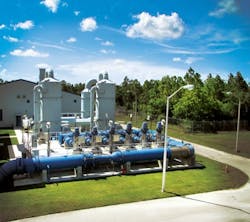Residents of the Florida Keys carefully conserve costly freshwater to minimize their bills. Florida Keys Aqueduct Authority’s (FKAA) conservation efforts have successfully driven down consumption, but with water bills tied to usage, the same amount of infrastructure has to be maintained with less revenue. As a result, FKAA sought ways to reduce operating costs and avoid rate increases.
Determining Usage
Today, FKAA delivers an average of 17 million gal per day of water to 49,000 connections. Its transmission line traverses 130 miles through three different electric power suppliers serving FKAA, each with its own pricing structure. At first, FKAA tried saving money with simple measures, such as turning off computers and lights. But those measures were not enough to offset the revenue losses and ever-increasing costs of maintaining the system. That was when FKAA decided to look at pumping costs, but found that facilities had a mismatched collection of electrical meters of varying accuracy, with many not working.
Jim Brewster, FKAA’s electrical instrumentation controls manager, chose Schweitzer Engineering Laboratories Inc. (SEL), a manufacturer of electrical protection, controls and communication devices, to install high-accuracy power metering to measure the effectiveness of FKAA’s efforts. SEL revenue meters provided the data FKAA needed to analyze its situation.
However, as Roy Coley, FKAA manager of operations, pointed out, “When you don’t know how much a kilowatt costs, that information isn’t useful in real time. Not everyone is an electrical engineer who understands kilowatt and demand charges.”
Brewster and Coley experimented with several ways to give the operators energy consumption data before adopting a dashboard. By separating real-time energy consumption from peak demand and time-of-day rates, FKAA was able to reduce a monthly energy bill to real-time values in terms of dollars. FKAA worked with its integrator, CH2M, to prominently display this value on the HMI screen. Replacing kilowatt hours with dollars allowed operators to immediately see the cost of a process change in real time.
The final display was a “wire-to-water efficiency” showing power consumption expressed in dollars per thousand gallons of water delivered. Now operators can identify the most efficient pumps and economize the process by raising or lowering pressures in various zones to increase efficiency.
Measurable Savings
The data from the energy meters revealed that one pump was switching on and off excessively; installing a variable-frequency drive could save 30% in energy costs. In another location, the data showed a high-service pump that was running unnecessarily. FKAA now is realizing longer run times, has reduced starts and stops, and has eliminated unnecessary pumping. As a side benefit, the energy meters captured some anomalous power events that FKAA shared with the power utility, which initiated power quality improvements that will benefit FKAA and its communities.
The new system “saves on maintenance, too,” Brewster said. “When they don’t run the motors or when the motors keep a constant speed, the motors are not being stressed. Suddenly, your whole operation’s cost comes down.”
With a portion of the money saved, FKAA invested in SEL-849 motor management relays to improve the visibility of motor starts, stops, run time, efficiency and early detection of problems across the pumping system. The savings have been a result of incremental gains in efficiency. With the success in the transmission system, FKAA now is looking for efficiency gains in the distribution system. “The more data we give the operators, the more ways they find to save,” Brewster said. “It’s having a chain reaction—everyone is always asking how they can save,” Coley added. “There will be savings on all the distribution pump stations, too. The payback is really quick—[sometimes] in a couple of months.”
FKAA’s initial investment of approximately $60,000 now is yielding $600,000 per year in electrical savings. The payback time has been short due to the ability of the operations crew to immediately see the results of process changes and the ability of the electrical instrumentation group to share actionable data with the operators.
FKAA is installing SEL power metering at each distribution station. So far, it has installed 15 and plans to install another 30. The wastewater treatment plant is taking notice and plans to adopt a similar approach to increase its efficiency.
Overall, FKAA identified three main contributors to its success. The first was the decision to look at the pumping operations with a view toward efficiency despite long-standing operating procedures and the natural inclination to resist change. Next was investing in the infrastructure and working together to obtain and convert a complex power bill into understandable and actionable data. The third was putting the information into the operators’ hands. Together, managers and operators are making cost-saving decisions based on real-time information and enjoying friendly competition to see who can deliver water at the lowest cost.
Coley and Brewster explained that as other operational budgets feel the effects of successful water conservation efforts, FKAA has been able to keep its budget flat and rates stable, and continue with capital improvements and staffing plans. This is a win for customers and commissioners, who do not have to contend with another rate increase. Operators have not experienced wage freezes, and the utility has continued to improve the system. In short, FKAA has not had to raise rates or reduce customer service while water continues to be conserved.
Download: Here


